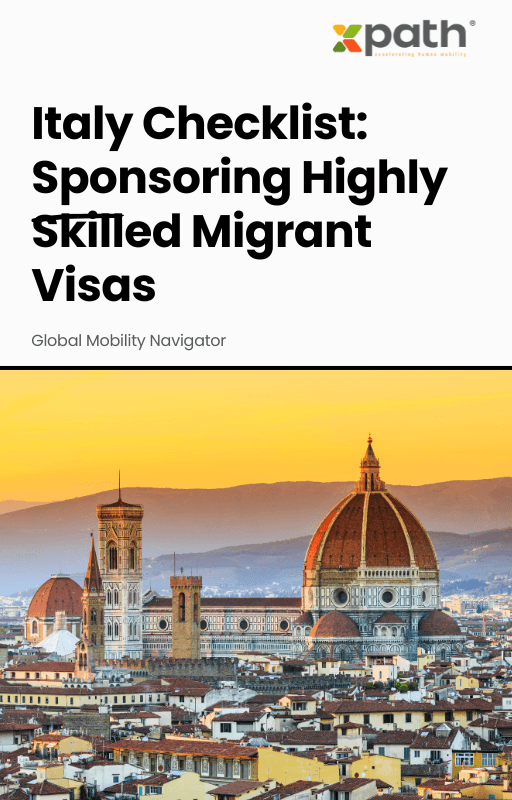Italy Checklist: Sponsoring Highly Skilled Migrant Visas
Grab a copy of a guide to international employee relocation
View E-bookImagine earning your salary while sipping coffee in Berlin, but your employer is based in New York. Seems idyllic, right? Not so fast. Under many global tax regimes, you could be taxed on your income both in Germany and the United States. This scenario—where two different authorities lay claim to the same earnings—is called double taxation. And with a 2023 Gartner study revealing that 58% of employees have considered cross-border remote work, it’s no longer a niche topic. As the world grows more interconnected, understanding double taxation becomes critical for companies and workers chasing global mobility.
Double taxation crops up when two countries simultaneously treat you as a tax resident or tax income sourced within their borders. It often happens when:
Research by KPMG shows that 41% of global mobility professionals flagged double taxation as a top compliance worry post-pandemic. With new work models mushrooming, the risk is only intensifying, especially for companies lacking robust global mobility solutions.
To truly grasp the scope, let’s look at the figures. The OECD estimates that 185 million people now work remotely at least part-time in international contexts. Surveys indicate that about 27% of cross-border remote workers experience some form of double taxation or conflicting tax obligations. This isn’t just a paper-pushing problem. Tax mistakes can trigger fines, reputational fallout, and even legal action. In 2022, a tech giant faced multimillion-dollar penalties in the EU after overlooking remote taxation for hundreds of employees. These are headaches no business or professional wants.
For HR and mobility leaders, the terrain is tricky. On one hand, you want to offer flexible work to attract international talent. On the other, the web of local regulations, payroll registrations, and tax treaties can feel endless. A survey by PwC highlights that 67% of organizations are “concerned” or “very concerned” about their ability to track remote employee locations—a critical factor in determining tax residency and thus exposure to double taxation. Without a comprehensive global mobility solution, companies risk both non-compliance and employee dissatisfaction.
So, what can you do to sidestep this minefield? Start with awareness. Map where your remote staff actually work—not just on paper. Then, consult international tax advisors and leverage technology to automate compliance checks. Many global mobility platforms, like xpath.global, integrate location tracking, real-time regulation updates, and double tax treaty insights all in one place. This means you can streamline processes, spot risks early, and ensure your global teams remain both productive and compliant.
It’s also essential to build clear company policies. Specify the countries from which remote work is permitted, and outline tax implications up front. Some businesses require prior approval for cross-border remote work or provide resources to help employees file taxes in multiple jurisdictions. Think of it as fence-building before the horses bolt—prevention is always better than cure.
Consider the case of a UK fintech that expanded its remote talent pool to Southeast Asia. Initially, employees faced double taxation due to overlooked local filings and misclassified work locations. The costs escalated rapidly: unhappy staff, missed tax credits, and audit threats. Enter a global mobility solution like xpath.global. By automating residency assessments, tracking cross-border workdays, and advising on tax treaties, the fintech slashed compliance costs and doubled employee confidence. Staff could work flexibly—without the fear of losing income to unexpected tax bills or legal trouble.
The rise of remote work promises incredible freedom, but double taxation remains a lurking storm cloud. Fortunately, with the right mindset, technology, and proactive strategies, both businesses and remote professionals can enjoy global mobility without double the tax pain. Knowledge is your umbrella. Equip yourself, set clear policies, and don’t hesitate to lean on specialized partners like xpath.global.
What is double taxation in remote work?
Double taxation is when two tax authorities (usually countries) levy taxes on the same income, often affecting remote workers who split their work across borders.
How can I avoid being double taxed?
Know the rules of the countries where you live and work, check for double taxation treaties and consult with tax experts or global mobility platforms for guidance.
What are double tax treaties?
They’re agreements between countries ensuring income isn’t taxed twice—either giving credits, exemptions, or splitting tax rights for workers straddling both locations.
Can technology help with double taxation compliance?
Absolutely! Platforms like xpath.global offer automated compliance checks, tracking, and policy support to help companies and individuals stay protected.
Why should organizations invest in global mobility solutions?
To streamline processes, ensure compliance, reduce risk, and support international talent—all critical for thriving in today’s mobile work landscape.
Ready to transform your mobility program? Explore xpath.global’s solutions.

Italy Checklist: Sponsoring Highly Skilled Migrant Visas
Grab a copy of a guide to international employee relocation
View E-book